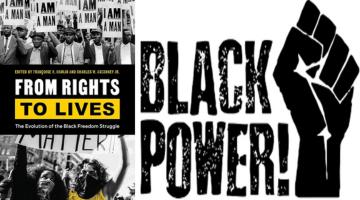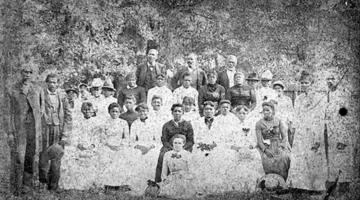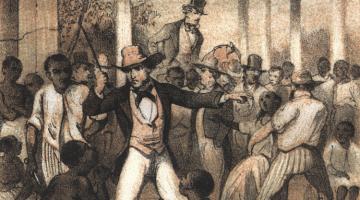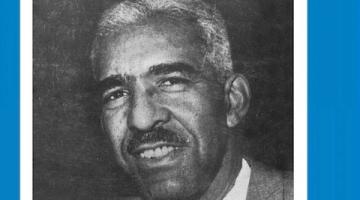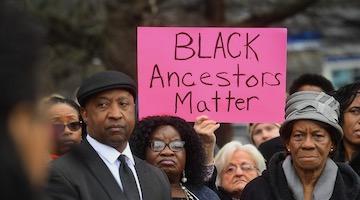Slavery and the Civil War were central to the development of photography as both a technology and an art.
“Matthew Fox-Amato’s Exposing Slavery is a valuable aid for thinking through the tangle of issues around race, sight, power, and bodies.”
Review:
Exposing Slavery: Photography, Human Bondage, and the Birth of Modern Visual Politics in America
Matthew Fox-Amato
Oxford University Press, $39.95 (cloth)
Lawsuits against Harvard University have kept the school’s race relations in the news lately. During the fall and winter, a case alleging that Harvard discriminated against Asians in its admissions dominated national headlines for months. In a more recent, and less reported, case, an African American woman named Tamara Lanier has sued the university to reclaim photographs of her enslaved relatives and for “unspecified punitive and emotional damages.” The photographs in question were part of the personal collection of Louis Agassiz. Agassiz, one of the most important naturalists of the nineteenth century and founder of Harvard’s Museum of Comparative Zoology, was also an advocate for the scientific hypothesis that people of color are inferior to whites.
Harvard rediscovered the daguerreotypes in its archives in the mid-1970s. The images, taken around 1850, are some of the earliest photographs of enslaved people in the United States, which also makes them some of the earliest portrait photographs. Unforgettable are the startled, horrified, desperate, and deeply arresting gazes of the sitters. The images are so remarkable that artist Carrie Mae Weems used them for her blistering series From Here I Saw What Happened and I Cried (1995). In response, Harvard threatened to sue Weems for copyright infringement (in a surprise resolution, the university instead acquired Weems’s series). Legal issues of ownership aside, Lanier’s most arresting claim is that she and her family, as descendants of the enslaved people depicted in the photos, have been violated by the images—as have their ancestors, who bodies have been kept in a kind of perpetual exposure, a permanent state of trauma. This echoes Saidiya Hartman’s claim, in Scenes of Subjection (1997), that the circulation of depictions of slavery reproduce its abjection, and that as a result the dead are never safe from the living. When I learned that Lanier’s lawyer represented Trayvon Martin’s family, my mind went immediately to another murdered black teenager, Michael Brown: to the way that his body was photographed and filmed dead on the ground with no one shielding him and few demanding that the image-making stop. Lanier’s case is based on her status as a descendant of enslaved people, but by extension it is also about the continued violations, humiliations, and violence U.S. visual culture reigns down on black bodies.
Matthew Fox-Amato’s Exposing Slavery is a valuable aid for thinking through this tangle of issues around race, sight, power, and bodies. For Fox-Amato, slavery and the Civil War were central to the development of photography. This is consistent with what we know about how major historical events shape visual culture and art. This is true of historical analysis, as well: events lead and images trail behind. Rare is the history book that includes more than six or seven images as illustration for the text. Indeed, academic presses actively discourage more than that, as both too expensive and negligible to the scholarly value.
As Fox-Amato shows, both sides of the debate over slavery—and then of the war fought in its name—were interested in the power photography seemed to possess to document objective truth. As a result, we must reorient our thinking to see “photographic self-representation as a historical force.” Equally crucial, we must “reconceiv[e] the past as a world of picture-makers.” For black Americans, photographs—and especially composed portraits—served as documents of selfhood, power, and presence. Photography also empowered white slave-owners and abolitionists in more openly polemical ways, documenting slavery or staged depictions of it to alternately uphold or condemn it.
“We must reorient our thinking to see ‘photographic self-representation as a historical force.’”
Fox-Amato begins by confronting photographs slaveholders had taken of the people they held in bondage. Even prior to the advent of photography, slaveholders visually documented their slaves in various ways, in some cases including them in family portraits, echoing the use in European portraiture of the blackamoor, the figure of a black person who served as a sign of wealth and worldliness. Photography, however, made it massively easier and cheaper to produce such objects, allowing “slaveholders to build up a new visual world.” In this new visual regime, images of enslaved people both documented slaveowner’s wealth and property and, in some cases, proposed visual evidence that slavery was benign. But through the very act of creating individualized depictions of enslaved people, slaveowners undermined one of the base arguments in favor of slavery—namely, that slaves were not humans but fungible objects. This paradox did not seem to bother slaveholders but, as Fox-Amato notes in a clever turn of phrase, “masters could never completely master the meaning of slave photographs.”
In other words, photography was an unstable weapon of racial domination, and enslaved people quickly adopted this new technology as a tool for liberation, both personally and politically as part of the abolitionist movement. Enslaved people in some cases were able to earn small amounts of disposable income, and it turns out that many were eager to spend it having photographic portraits made of themselves. Fox-Amato offers detailed evidence of southern photography studios that actively courted enslaved clientele. John W. Bear, for example, took up photography in 1845 and “reserved every Friday afternoon for colored people . . . and slaves would be taken for fifty cents less than others.” He adds, “this made me very popular with them.”
“Enslaved people quickly adopted this new technology as a tool for liberation.”
Fox-Amato tenderly unspools how fundamental photography became to asserting kinship and love for a people whose circumstances unrelentingly reminded them that they possessed no legal rights to either. He notes several cases of photography being used by freed blacks to identify and purchase their relatives, to remember family members sold off to other plantations, and as an indelible way of recording familial units that were always under threat of being violently, forcibly separated. In other words, photographs operated then, in extremis, in some of the same ways they operate now: as proof of life. That abolitionists both black and white latched on to the political power in such images is no surprise, given that in some sense even these intensely private images—with their “I am here” subtext—were always polemics of personhood and citizenship.
The book’s material specifically about photography’s use to document the Civil War is its most familiar and also the place where Fox Amato’s optimism about the power of images begins to sour. Photography, this new technology which had such democratizing promise, largely ends up being another tool for Union soldiers and northern white picture-takers to imagine themselves as heroes and blacks as subservient. Fox-Amato tries gallantly to end on a positive note, but when only a few pages earlier he notes the rise in lynching photographs that followed the war—and indeed only grew in popularity during the twentieth century—the reader can feel his faith in the visual cracking. Sure, photography changed the world, but was it really for the better?
“In some sense even these intensely private images—with their “I am here” subtext—were always polemics of personhood and citizenship.”
Fox-Amato is not the first scholar to point out the fundamental restructuring of political and personal identity that photographs created. But he is one of the rare historians to posit that this is not only a concern for art history or visual studies, but instead crucial to understanding the history of the Civil War, its prelude, and aftermath. This seems obvious, but that stance makes Fox-Amato’s book surprisingly radical. As noted, historians have long been encouraged by presses—and, indeed, by art historians—to leave images to the “experts.” Even as art history and visual culture studies vastly enlarged their disciplines since the 1990s—eagerly absorbing design histories, material culture studies, and all things digital—historians have been slow to the party. Fox-Amato diplomatically chalks this up to “a preference for written over visual sources.” It is, however, more insidious than that. By undervaluing images, by making them peripheral, historians have been able to write around some of the most unstable, affective, and indeed unreliable historical documents that we have, the most indeterminate records of what has happened. Written texts are, to commit a tautology, so much more readable than images are. Yet to exclude them is to exclude much of the documentary evidence of the last two centuries. That this even needs saying is an indication of the urgency of Fox-Amato’s book.
If Fox-Amato’s book runs into a narrative problem, part of the issue might be in the way he frames history and the visual. Trying to convince historians of the importance of his arguments, he writes in the introduction, “The promise that visual studies offers history is twofold.” Only two? And, to turn the phrase, what does all this history do for visual studies? If visual studies offers anything to the larger critique of the humanities, it is that this kind of disciplinary thinking underestimates the very sneaky way the visual has already created the options that people believe they must choose between. The visual is not what happened and then was illustrated, and it is not also just a technology. We can see differently with photography and the digital, but since each “new” visualization simply builds on the previous iconographic history, there is really nothing visually new under the sun (or, in outer space either). We make images to reign in and imagine our worlds, but that becomes the field we have to play on. The visual does not have a straight line, it is not a neat chronology, it moves all around unrelentingly.
“Visual culture demands at every turn that we consider whose pain or agency matters most.”
This process is laid bare in Cheryl Finley’s Committed to Memory: The Art of the Slave Ship Icon (2018). In charting the visual paths of the iconic slave ship, Finley suggests it is helpful to consider this visual trajectory as a “mnemonic aesthetic” or the “symbolic possession of the past.” The slave ship image moves, shifts, and bends across time and space and Finley reminds us that “these aesthetic strategies of repetition and rhythm are mobilized in a concentrated effort to keep hold of a memory that threatens to disappear.” Memory is the way images find their hold and power, they absorb and leach, now and then. Images do not need history, therefore, as they have already absorbed it and moved on. To turn the question visual culture scholar W. T. Mitchell asked us years ago, “What do pictures want?” it might help to ask, “What do pictures want from us?” Is this an abusive relationship we should quit? For as Fox-Amato seems to realize, even as an image empowers, somewhere, somehow, it is getting twisted.
And so we are stuck, it would seem, with our creations that constantly threaten to overtake us. Is the answer proper ownership and stewardship of pictures? Can we ever, no matter the technology, control these images? Fox-Amato wants to convince historians that pictures matter, but if historians have been slow embrace to embrace this advice, it may ironically be motivated by a recognition that images are powerful. More than this, they usually lead, not follow. Visual culture demands at every turn that we consider whose pain or agency matters most. History catches up to this, not the other way around. Lanier’s lawsuit should remind us that these traumas, once seen, cannot be unseen, or stored away, ignored, or eased by words. We ignore the visual and slight its power at our own risk.
Alexis L. Boylan is Associate Professor of Art and Art History and Africana Studies at the University of Connecticut, and is Director of Academic Affairs for University of Connecticut’s Humanities Institute. She is author of Ashcan Art, Whiteness, and the Unspectacular Man and editor of Thomas Kinkade: The Artist in the Mall.
This article previously appeared in Boston Review.
COMMENTS?
Please join the conversation on Black Agenda Report's Facebook page at http://facebook.com/blackagendareport
Or, you can comment by emailing us at comments@blackagendareport.com



